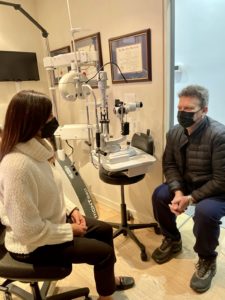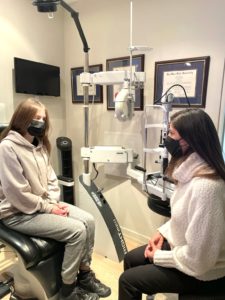March 1, 2022
By Vishakha Thakrar, OD, FAAO, FSLS
Education to manage the expectations of our patients before commencing treatment is critical.
Myopia management options are growing rapidly. It can be easy to implement treatments such as myopia control ophthalmic lenses, contact lenses, and low-dose atropine into clinical practice. There is compelling evidence to demonstrate to parents that these therapies effectively slow the progression of myopia. Still, no therapy guarantees that it will halt myopia progression. For this reason, it is essential to manage the expectations of parents and children. We need to access pertinent information to confidently and articulately educate our patients’ parents about myopia management.
The Myopia Management Consultation
Single vision glasses and contact lenses are the traditional correction methods for myopia. When we layer our recommendations to include myopia control, parents may become confused, particularly if they have limited experience with vision correction. I start my conversations with parents prior to the onset of myopia, particularly if the child is at high risk of developing myopia. This way, they are prepared if their child does become myopic. I usually have a short discussion during the eye exam explaining that there are methods to slow down the progression of nearsightedness. If the patient has developed myopia, then we schedule a separate consultation. Usually, this consultation is a designated time to conduct additional tests and provide the best possible recommendations to the parents and children.
Case History and Exam: This is the time to gather relevant information, including the age of onset of myopia, race, parental and sibling presence and degree of myopia, daily activities, outdoor time, and device time. Next, vital measurements, such as refractive error (dry and cycloplegic), corneal topography, binocular vision status, pupil size, and axial length measurements provide baseline data.
Why does myopia need to be treated? Of course, the progression of myopia is an inconvenience because of the increase in blurred vision. However, the discussion around potential reduction in the risk of macular degeneration, glaucoma, cataracts, and retinal thinning disorders is compelling.1-4 Myopia at any degree increases the chance of these pathologies.5 Parents only want the best for their children, so the possibility of reducing future eye disease is essential information that they want to hear from us.
Recommendations: The examination and case history provides the needed information to make appropriate recommendations. Current modalities that our practice utilizes include low-dose atropine, orthokeratology, soft myopia control contact lenses, and myopia control ophthalmic lenses. These modalities work very well, but the purpose of treatment is to slow myopia, not to stop it. The earlier the intervention, the better potential prognosis.6 The most rapid axial growth occurs during the year before myopia onset.7
Should we discuss efficacy between methods? Efficacy is no longer the best way to compare different treatment methods because of varying study durations, different endpoints, and inconsistent demographics between studies.8 A comprehensive review by Brennan et al., 2021 found that the efficacy between most methods of myopia control is relatively similar, with the exception of 0.01% atropine and progressive addition spectacle lenses.8 For this reason, I weigh my decision highly on the case history, the exam data, and the family’s comfort level. For example, if the child is a soccer player, I would likely choose orthokeratology or soft myopia control contact lenses. If the child and/or the parents are terrified of putting anything in the child’s eyes, then novel myopia control glasses are the obvious choice. If the child is 5 years old and is already a -2.00D myope, then combination therapy and proper guidance around expectations are necessary.
After recommending the modality or modalities, I explain what is involved and the mechanisms of action. I like to include studies in my myopia management package, particularly for orthokeratology9 and atropine therapy10 in case patients doubt the safety and efficacy of the proposed treatment. Manufacturers also provide highly engaging patient education materials, including Johnson & Johnson Vision’s Managing Myopia — A Clinical Response11 and CooperVision’s Brilliant Futures Myopia Management Program.12 I try to ensure that the parents understand why I am making each recommendation, and I am clear that the treatment regimen may change if we are not reaching our desired goals. I also present the option of combination therapies to offer more reduction in progression, if necessary.
Parents also want to know the expected duration of treatment. We should educate that myopia management is an ongoing process and could continue beyond the teen years depending on the progression. Current data suggests that 50% of myopes progress after the age of 16,13 and 20% of myopes will progress into their 20s.14 The response to treatment may vary per patient and depends on the age of onset, family history of myopia (including the degree of myopia,) near point activities, device time, outdoor time, compliance, etc.
Myopia Control Package
Myopia management is a therapy that will likely be ongoing for several years. Vision care insurance may cover the cost of a comprehensive eye exam but likely not myopia management fees. For this reason, write down the total cost to the patient for the parents before commencing treatment.
It is great to consolidate all of this information into a myopia control package. The amount of information provided to parents is quite vast, so the package acts to simplify this information. It should include handouts and studies on recommended treatments, informed consent, manufacturer information, pricing, and a business card for the contact person at the office.
The myopia management conversation has become easier than ever as more treatment modalities have become available. Education to manage the expectations of our patients before commencing treatment is critical. These conversations allow parents and their children to clearly understand the therapy and the commitments involved in myopia management. Thorough discussions lead to far more successful myopia management outcomes for patients and their parents.
 |
Dr. Vishakha Thakrar is the owner of Vaughan Vision Centre, a practice specializing in myopia control, contact lenses, and dry eye in Vaughan, Ontario. She is residency trained in cornea and contact lenses. She previously held the role of Director of the Contact Lens Service at the Cleveland Clinic. She is a fellow of the American Academy of Optometry and the Scleral Lens Society. She currently sits on the board for the Contact Lens Section of the CAO and the RCCO Contact Lens Working Group, and she is a Myopia In Practice Study Investigator and a principal organizer for the CCLA Conference. |
References
- Ohno-Matsui K et al. Updates of Pathologic Myopia. Prog Retin Eye Res 2016;52:156-87.
- Pan CW et al. Myopia and Age-Related Cataract: A Systematic Review and Meta-Analysis. American Journal of Ophthalmology 156.5 (2013): 1021-1033.
- Mitry D et al. The Epidemiology of Rhegmatogenous Retinal Detachment: Geographical Variation and Clinical Associations. Br J Ophthalmol 2010;94:678-84.
- Marcus MW et al. Myopia as a Risk Factor for Open-Angle Glaucoma: A Systematic Review and Meta-Analysis. Ophthalmol 2011;118:1989-94.
- Perkins ES. Morbidity from Myopia. Sight Sav Rev 1979;49:11-9.
- Chua SY, Sabanayagam C, Cheung YB, Chia A, Valenzuela RK, Tan D, Wong TY, Cheng CY, Saw SM. Age of onset of myopia predicts risk of high myopia in later childhood in myopic Singapore children. Ophthalmic Physiol Opt. 2016;36(4):388-94.
- Mutti DO, Hayes JR, Mitchell GL, Jones LA, Moeschberger ML, Cotter SA, Kleinstein RN, Manny RE, Twelker JD, Zadnik K; CLEERE Study Group. Refractive error, axial length, and relative peripheral refractive error before and after the onset of myopia. Invest Ophthalmol Vis Sci. 2007.
- Brennan NA, Toubouti YM, Cheng X, Bullimore MA. Efficacy in myopia control. Prog Retin Eye Res. 2020 Nov 27:100923
- Bullimore MA and Johnson L. Overnight Orthokeratology. Contact Lens and Anterior Eye.2020 August; 43(4):322-332.
- Yam et al. Low-Concentration Atropine for Myopia Progression (LAMP) Study: A Randomized, Double-Blinded, Placebo-Controlled Trial of 0.05%, 0.025%, and 0.01% Atropine Eye Drops in Myopia Control. Ophthalmology. 2019 Jan;126(1):113-124.
- Managing Myopia A Clinical Guide to the Growing Epidemic, Johnson & Johnson Vision Care.
- Brilliant Futures Myopia Management Program, CooperVision.
- COMET Group. Myopia stabilization and associated factors among participants in the Correction of Myopia Evaluation Trial (COMET). Invest Ophthalmol Vis Sci. 2013 Dec 3;54(13):7871-84.
- Parssinen O, Kauppinen M, Viljanen A. The Progression of Myopia From Its Onset at Age 8-12 to Adulthood and the Influence of Heredity and External Factors on Myopic Progression. A 23-year Follow-Up Study. Acta Ophthalmol 2014;92:730-9.















